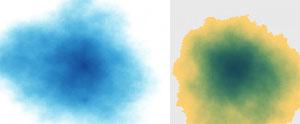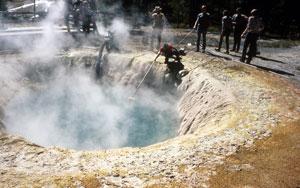Over the past century and more, tourists to Yellowstone National Park have marveled at the colors in the park's hot springs. Unfortunately, some of those visitors can't resist tossing coins, trash and other foreign objects into the thermal pools.
Scientists have wondered how all that activity may have changed the composition and appearance of those springs, and a recently-released study offers some answers to those questions.
The project, conducted by researchers at Montana State University and Brandenburg University of Applied Sciences in Germany, "led to creation of a simple mathematical model, based on optical measurements, that explains the stunning colors of Yellowstone National Park's hot springs."
The model also offers a look back into the past: it can "visually recreate how [the hot springs] appeared years ago, before decades of tourists contaminated the pools with make-a-wish coins and other detritus."

The model's prediction of color in Morning Glory Pool in earlier years (on the left) and now (on the right) are remarkably similar to actual photos. Image courtesy of Nugent, Shaw, and Vollmer.
"What we were able to show is that you really don't have to get terribly complex'you can explain some very beautiful things with relatively simple models," said Joseph Shaw, a professor at Montana State University and director of the university's Optical Technology Center. Shaw, along with his Ph.D. student Paul Nugent and German colleague Michael Vollmer, co-authored the new paper.
Study's Model Offers a Look Into the Past
Their model, along with "stunning pictures of the springs," was released on December 19 in the journal Applied Optics, which is published by The Optical Society (OSA).
Using handheld spectrometers, digital SLR cameras for visible images, and long wave infrared thermal imaging cameras for non-contact measurement of the water temperatures, the group took measurements at a number of pools in Yellowstone, including Morning Glory Pool, Sapphire Pool and Grand Prismatic Spring. Using these data, along with previously available information about the physical dimensions of the pools, they were able to create a simple model whose renderings of the pools were strikingly similar to actual photographs.
In the case of Morning Glory Pool, the researchers were even able to simulate what the pool once looked like between the 1880s and 1940s, when its temperatures were significantly higher.
The Previous Color of Morning Glory Pool Was Much Different Than We See Today
The study's authors note that during the earlier time period, the pool's waters "appeared a uniform deep blue. An accumulation of coins, trash and rocks over the intervening decades has partially obscured the underwater vent, lowering the pool's overall temperature and shifting its appearance to a terrace of orange-yellow-green. This change from blue was demonstrated to result from the change in composition of the microbial mats, as a result of the lower water temperature."
"A general relationship between shallow water temperature (hence microbial mat composition) and observed colors was confirmed in this study," the authors continued. "However, color patterns observed in deeper segments of the pool are caused more by absorption and scattering of light in the water. These characteristics'mats having greater effect on color in shallow water, and absorption and scattering winning out in the deeper areas'are consistent across all the measured pools."

A postcard c. 1930 - 1945 shows Morning Glory Pool from an earlier era. Image courtesy of Boston Public Library.
Scenes on postcards dating from about 1918 through the mid-1950s confirm the study's conclusion, and show views of Morning Glory Pool that are almost entirely blue in color.
Damage from Human Vandalism Dates to Earliest Years of the Park
Damage to park thermal features from thoughtless human activity has a long'and unfortunate'history. According to a park publication, "Vandalism to Morning Glory Pool began early. The spring originally had a scalloped sinter border, 6-10 inches wide and 2-5 inches high. The entire rim was dismantled by souvenir hunters. By the 1950s, people had thrown so much trash, rocks, logs, and coins into the spring that Morning Glory Pool became known informally as the 'garbage can.'"
"Much of the debris became embedded in the sides and vent of the spring, affecting water circulation and decreasing the water temperature. Consequently, yellow and orange microorganisms, previously unable to live in hotter water, have spread towards the center of the pool, decreasing the area of clear blue."
A study on human impacts on geyser basins, published in 2009 the journal Yellowstone Science, points out that easy vehicular access to thermal features increased the problems with vandalism in years past.

Siphon being used to clean Morning Glory Pool in 1975. NPS photo.
"Morning Glory Pool, in the Upper Geyser Basin, is perhaps the most notorious damaged feature within the park," that article notes. "Before the highway was diverted away from Morning Glory in 1971, its easy access and high popularity caused the spring to be the receptacle for large quantities of objects, including coins, rocks, logs, bottles, and clothing."
Efforts to Remove Foreign Objects from the Hot Spring Have Not Reversed Changes
"Many efforts were made to remove items from the spring, but the continual addition of material clogged the vent, perhaps enough to lower the spring's temperature and allow the growth of algae."
A surge in visitation to the park after the end of World War II also marked an increase in damage to thermal features. In 1947 Park geologist George Marler reported hauling 55 wheelbarrows full of rocks and debris from springs and geysers in addition to a large tree from Emerald Pool, stating that 'the culprits had resorted to considerable labor to drag this tree to the pool and shove it in.'
We can only hope that continued efforts toward public education will reduce further damage to these special features that are such an important part of Yellowstone. Perhaps studies such as the recent one on the hot springs will help visitors understand that our actions, even those that may seem relatively harmless, can have a big impact on park resources.
There's Still Plenty to Learn About Yellowstone
This research also offers a reminder that there's still plenty to learn, even in a park that's been studied as extensively as Yellowstone.
"When we started the study, it was clear we were just doing it for fun," Vollmer said. But the trio of scientists quickly discovered there was very little in the scientific literature on the subject. "That's when things got interesting, Vollmer continued."
"We didn't start this project as experts on thermal pools," Shaw noted. "We started this project as experts on optical phenomena and imaging, and so we had a lot to learn."
"There are people at my university who are world experts in the biological side of what's going on in the pools," Shaw said. "They're looking for ways to monitor changes in the biology'when the biology changes, that causes color changes'so we're actually looking at possibilities of collaborating in the future."










Comments
in 1959 i visited Yellowstone & remember seeing the blue Morning Glory pool! My dad took a picture of it & I viewed it often growing up. I'm extremely saddened to hear rhe color has changed to a green & yellow due to vandals!